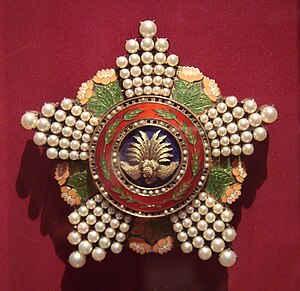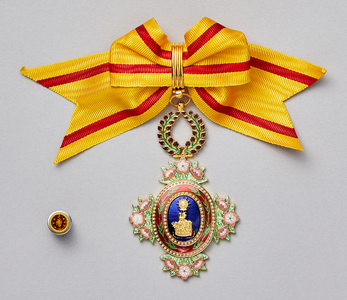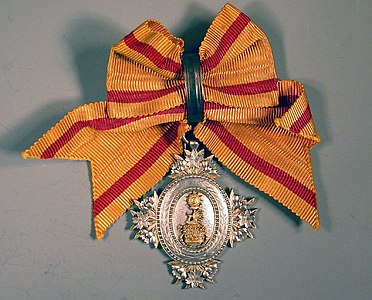Order of the Precious Crown
| Order of the Precious Crown 宝冠章 | |
|---|---|
Order | |
| Criteria | At the monarch's pleasure |
| Status | Currently constituted |
| Sovereign | HM The Emperor |
| Classes | 1st through 8th Class |
| Precedence | |
| Next (higher) | Order of the Paulownia Flowers |
| Next (lower) | Order of the Rising Sun Order of the Sacred Treasure |
The Order of the Precious Crown (宝冠章, Hōkan-shō) is a Japanese
Until 2003, the Order of the Precious Crown, which had eight ranks, was equivalent to the Order of the Rising Sun and was awarded as a women-only version of the Order of the Rising Sun.[1] In 2003 the Order of the Rising Sun, previously reserved for males, was made available to women as well, and the lowest two classes of the Order of the Precious Crown were abolished.[1] Since 2003, the Order of the Precious Crown has only been given to female members of the imperial family in Japan and female members of the royal family in foreign countries only when it is specifically necessary for diplomatic ceremonies.[1]
Since 2003, the number representing rank included in the official name of the order was removed. As a result, although numbers representing ranks were sometimes used in common names, the formal names such as 勲一等 (Kun-ittō, First Class) and 勲二等 (Kun-nitō, Second Class) were no longer used.[2]
In 1907, medals of the Order of the Crown were bestowed upon twenty-nine
Classes
The first class honour has been typically conferred to female royalty. As originally conceived, the order consisted of eight classes. Unlike its European counterparts, the order may be conferred posthumously.
The badge of the order is a gold oval medallion, with floral designs at its four ends; at the centre is an ancient Japanese crown on a blue background, surrounded by a red ring. It is suspended from a smaller badge, its design varies according to class, on a ribbon in yellow with red stripes near the borders, as a sash on the right shoulder for the 1st class, as a bow on the left shoulder for the other classes.
The star of the order, which is worn only by the first class, has five rays studded with
The medal for the 6th and 7th classes are golden bronze. The face presents the crossed flags of Japan and the Emperor, both of which are surmounted by the Rising Sun. The obverse presents a conventional monumental shaft, which is flanked by a branch of laurel and a branch of palm.[3]
-
Grand Cordon of the Order of the Precious Crown (1st class)
-
The Order of the Precious Crown, Peony (2nd class)
-
The Order of the Precious Crown, Butterfly (3rd class)
-
The Order of the Precious Crown, Wistaria (4th class)
-
The Order of the Precious Crown, Apricot (5th class)
-
The Order of the Precious Crown, Ripple (6th class)
-
7th Class (Abolished in 2003)
-
8th Class (Abolished in 2003)
Selected recipients
First Class, Grand Cordon

- Empress Michiko
- Empress Masako
- Kiko, Crown Princess Akishino
- Aiko, Princess Toshi
- Mako Komuro
- Princess Kako of Akishino
- Sayako Kuroda
- Maria Teresa, Grand Duchess of Luxembourg
- Princess Salote Mafile'o Pilolevu Tuita of Tonga
- Queen Margrethe II of Denmark
- Empress Farah of Iran
- Queen Elizabeth The Queen Mother
- Queen Paola of Belgium
- Queen Silvia of Sweden
- Queen Sirikit of Thailand
- Queen Máxima of the Netherlands
- Queen Mathilde of Belgium
- Queen Sofia of Spain
- Queen Letizia of Spain[4]
- Queen Sonja of Norway
- Crown Princess Bangja of Korea
- Tuanku Budriah of Malaysia
- Tuanku Bainun of Malaysia
- Tuanku Fauziah of Malaysia [citation needed]
- Tuanku Hajah Haminah Hamidun of Malaysia[5]
- Princess Srinagarindra of Thailand
- Princess Sirindhorn of Thailand
- Princess Chulabhorn of Thailand
- Anne, Princess Royal
- Princess Margaret, Countess of Snowdon
- Princess Alexandra, The Honourable Lady Ogilvy
- Mette-Marit, Crown Princess of Norway
- Princess Basma bint Talal of Jordan
- Empress Dowager Cixi of China
- Queen Liliʻuokalani of Hawaii
- Queen Kapiʻolani of Hawaii
- Te Atairangikaahu
- Princess Sarvath al-Hassan of Jordan
- Princess Alia bint Hussein of Jordan
- Baroness Margaret Thatcher (former Prime Minister of the United Kingdom)
- Imelda Romualdez Marcos, former First Lady of the Philippines
- Siti Hartinah, former First Lady of the Republic of Indonesia
Second Class
- Noriko Senge
- Princess Tsuguko of Takamado
- Ayako Moriya
- Princess Akiko of Mikasa
- Princess Yōko of Mikasa
- Princess Alexandra of Luxembourg
Third Class
- Joyce Ackroyd, 1918–1991[6]
- Eleanor Jorden, 1920–2009[7]
- Elizabeth Gray Vining, 1902–1999[8]
- Lillian Moller Gilbreth, 1878–1972, Honor conferred 1968[9]
- Yoshi Kasuya, 1894–1994[10]
- Chika Kuroda, 1884–1968[11]
- Sugino Yoshiko, 1892-1978[12]
- Kono Yasui, 1880–1971[13]
- Toshiko Yuasa, 1909–1980[14]
Fourth Class
- Michiyo Tsujimura (1888-1969)
- Yvette Giraud (1916-2014)[15]
- Machiko Hasegawa (1920–1992)[16]
- Cayetana Fitz-James Stuart, 18th Duchess of Alba (1926–2014)
Fifth Class
- Fujima Kansuma (1918-2023)[17]
Sixth Class
- Anita Newcomb McGee,(1864–1940)[3]
- Fumiko Kouka Mikami, (1913-2019)[18]
Seventh Class
- William H. Brill, (1871–1923), Associated Press and Reuter's Telegram Company[3]
- Richard Harding Davis, (1864–1916) Collier's Weekly[3]
- John Fox, Jr., (1862–1919) Scribner's Magazine[3]
- The Outlook[3]
- Hearstpapers.
- Collier's Weekly[3]
- Herbert Ponting, photographer and journalist, (1870–1935), Harper's Weekly
- James Ricalton,[19] (c. 1844 – 1929) Travel Magazine[3]
- San Francisco Bulletin[3]
- Niijima Yae, (1845–1932)
See also
- Order of Chula Chom Klao (Thailand)
Notes
- ^ a b c d 栄典制度の概要. p.6 Cabinet Office (Japan)
- ^ 栄典制度の概要. p.5 Cabinet Office (Japan)
- ^ a b c d e f g h i j "Mikado Honors Americans; Order of the Crown Bestowed on Nurses and War Correspondents." New York Times. July 4, 1907.
- ^ "Letizia, la condecorada: las 17 distinciones que le han otorgado a la Reina". El Confidencial (in Spanish). 2017-04-24. Retrieved 2019-10-22.
- ^ "Raja Permaisuri Agong Tuanku Hajah Haminah receives highest honour from Japan". Bernama. 2013-02-07. Archived from the original on 2013-04-13. Retrieved 2013-02-07. Bernama has erroneously reported the Honours received as "Grand Cordon of the Order of the Chrysanthemum" while correctly citing the recipients of the "Grand Cordon of the Order of the Precious Crown"
- ^ Honor awarded 1983—The Australian Academy of the Humanities Proceedings 1991 p73 Archived 2009-09-15 at the Wayback Machine
- ^ Honor conferred 1985—National Association of Self-Instructional Language Programs (NASILP), Eleanor Jorden Archived 2010-09-18 at the Wayback Machine
- ^ Japan America Society of Greater Philadelphia: "The Emperor's Tutor"
- ^ As I Remember, Lillian M. Gilbreth, Engineering & Management Press, 1998, p. 244.
- ^ "Dr. Yoshi Kasuya ('23)". Wellesley College. Retrieved November 14, 2019.
- ISBN 978-1-57607-090-1.
- ^ 20世紀日本人名事典,367日誕生日大事典. "杉野 芳子(スギノ ヨシコ)とは". コトバンク (in Japanese). Retrieved 2019-10-25.
{{cite web}}: CS1 maint: numeric names: authors list (link) - ^ "Yasui, Kono (1880–1971)". Dictionary of Women Worldwide: 25,000 Women Through the Ages. 2007. Archived from the original on 24 February 2016. Retrieved 7 November 2015.
- ^ Yagi, Eri; Matsuda, Hisako (August 2007). "Toshiko Yuasa (1909-80): the First Japanese Woman Physicist and Her Followers in Japan" (PDF). AAPPS Bulletin. 17 (4): 15–17. Archived from the original (PDF) on 2015-07-12. Retrieved 6 November 2015.
- ^ "Hommage d'Aurélie Filippetti à Yvette Giraud". Archives Communiqués de presse (2012-2018). Ministère de la Culture. Retrieved 9 December 2019.
- The Asahi Shimbun Company. Retrieved 19 April 2021.
- ^ Murakami, Yuka (27 May 2020). "Madame Kansuma at 102: On Confinement and Little Tokyo's Cultural Heritage". Smithsonian. Washington, D.C.: Smithsonian Institution. Retrieved 21 November 2020.
- ^ "Those we lost in 2019". Rafu Shimpo. Los Angeles, California. 2 January 2020. Retrieved 21 November 2020.
- ^ Dava, Valerie. "World Traveler, Explorer, Photographer; James Ricalton brought the world to his Maplewood students," Matters Magazine
References
- Peterson, James W., Barry C. Weaver and Michael A. Quigley. (2001). Orders and Medals of Japan and Associated States. San Ramon, California: Orders and Medals Society of America. ISBN 1-890974-09-9
- Roth, Mitchel P. and James Stuart Olson. (1997). Historical Dictionary of War Journalism. Westport, Connecticut: ISBN 978-0-313-29171-5
External links
- Japan, Cabinet Office: Order of the Precious Crown
- Japan Mint


















